by: Lauren Licona
copyright 2020 Art of Living, PrimaMedia,inc
From quaint portraits of domesticity to elaborately staged spreads, when it comes to painting food, each brushstroke has intention. Food has always been a staple of culture and the subject of countless pieces of art. And while fads in portrayals of food have evolved from the still life (like Caravaggio’s Fruitbaket (1595–96), to the glossy, saturated adverts of the 1950s, to today’s high definition and meticulously composed Instagram posts, some things remain consistent: food is displayed with specific aesthetic goals and the intent to be visually arresting.
The renaissance was no different. Similar to advertisements and the perfected art of the promotional Instadish, food had subliminal meanings, associations, and significance in Renaissance paintings. Here, we’ll discuss some prevalent foods represented in renaissance art and their meaning.
Let’s start with the fruit
Probably the most recognizable and ubiquitous examples of food in renaissance art are the baskets and armfuls of fruit, but have you ever wondered why certain fruits were portrayed? One common reason is the symbolism and associations the fruit invoked.
For example, apples were the infamous fruit used to symbolize the food that tempted Eve, as well as an object that signaled beauty, health, and power. The role of the apple in renaissance art was paradoxical and changed with trends, epochs, and styles, and was painted by artists including Sandro Botticelli, Peter Paul Reubens, and Rembrandt.
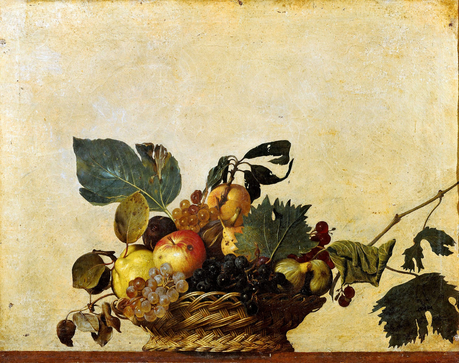
Caravaggio. Basket of Fruit. 1599. Biblioteca Ambrosiana, Milan.
Pomegranates and pears were also prevalently used for their symbolism, including associations with fertility due to their round shape, as well as pomegranate’s seeds.
Oranges were another “forbidden fruit” of the artistic movement. But in paintings such as Botticelli’s “Primavera”, and Domenico Veneziano’s St. Lucy “Altarpiece”, the orange alludes to the Medici family, a powerful Florentine family who held enormous prestige and influence in Italy from the 14th to 18th century. Resembling the brightly colored spheres on the Medici coat of arms, the orange was known as the “malus Medicus” or “medicinal apple,” which created a sort of pun on the family name.
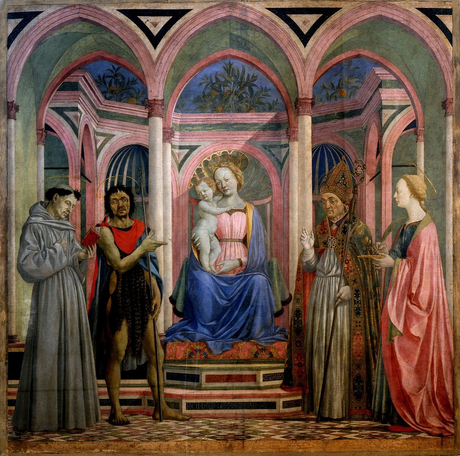
Veneziano, Domenico, Santa Lucia de’ Magnoli Altarpiece. 1445–1447.
Uffizi Gallary, Florence.
Whether to remind viewers of virtues and biblical allegories, represent beauty and luck, or allude to prominent figures in society, fruit was part of a rich visual language in Renaissance art.
Fish, festoons, and frescos
Another prevalent use of food in Renaissance paintings was to showcase abundance and flaunt wealth and prosperity. This can be seen in works such as “Still Life With Parrots” by Jan Davidsz, where the titular exotic bird stands perched atop a large spread of ripe fruit and expensive meats, including oysters and ham. Silver candelabras and plates are also present in the scene, which would appear exceedingly ostentatious to the average person of the time.
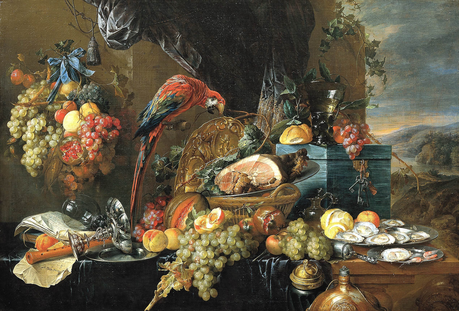
Davidsz, Jan. Still Life With Parrots. Late 1640s. The Ringling Museum, Sarasota.
Frescos by artists such as Cristofano Gherardi also highlighted the wide variety of ancient fruits, meats, and vegetables. Elaborate banquets and other scenes were portrayed, containing invaluable insights into Italy’s past biodiversity. Agronomist Dalla Ragione identified hundreds of Renaissance-era fruits, herbs, and vegetables using clues depicted in Renaissance frescoes and paintings well preserved in Italy’s palazzos and museums. She notes a particular study session in the library of the Castello Bufalini that had a profound impact on her historical and scientific research.
“I would sometimes look up to the ceiling to rest my eyes from reading,” she explained. “And I started to wonder if those frescoes could tell me something about ancient varieties.”
When we look at the vibrant frescoes that decorate many venues and institutions of the Renaissance age, we can see a plethora of foods portrayed: grains, fish, fruits, and others. Many of these scenes were painted with scientific accuracy and with inspiration from real-life, including those by students of 16th-century artist and historian Giorgio Vasari. Vasari encouraged his pupils to choose “real fruits” as subjects. “Gherardi painted cucumbers, melons, or pumpkins after studying them in real life,” Dalla Ragione says. “So they must have grown in nearby farmsteads or in local orchards.”
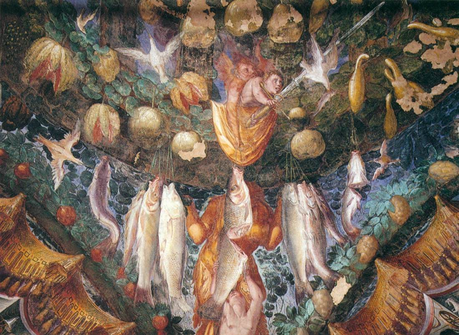
Gherardi, Cristofano. Festoon Decoration, Frescoes of the Garden Facade. (1534-7). Castello Bufalini, Umbria.
One Renaissance artist in particular went as far as to paint fantastical portraits using food to recreate the features of the subject’s face.
Giuseppe Arcimboldo began his career as a stained glass and fresco designer. He eventually landed the position of court portraitist to Emperor Maximilian II of the Holy Roman Empire in 1562. Along with traditional portraits of nobility, he began to composite a series of faces set against pitch-black backgrounds and made of objects, animals, and most notably, food. Emperor Maximilian II and his son Rudolf II were reportedly delighted by Arcimboldo’s style, and his noble patrons developed a taste for the unusual. Arcimboldo was renowned during his life, and his artwork eventually inspired the surrealists of the 20th century
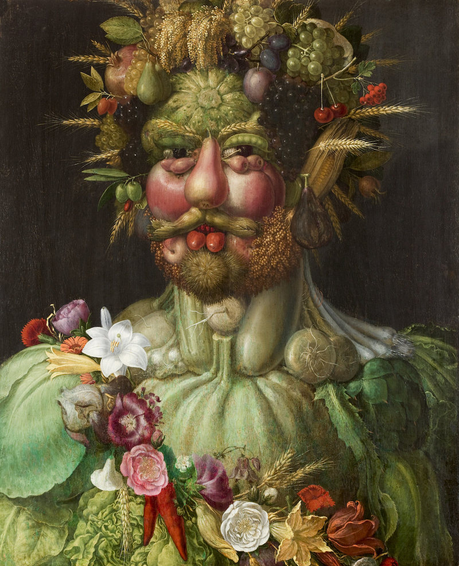
Arcimboldo, Giuseppe. Vertumnus. 1590–1591. Skokloster Castle, Sweden.
Here, Arcimboldo portrays Emperor Maximillian as, Vertumnus, the Roman god of the four seasons, using produce from each season and showcasing the age of abundance that supposedly took place under his rule.
Don’t Forget the FOMO
Using food aesthetics to induce a fear of missing out did not begin with the Instagram snapshot, although the latter is certainly quicker to produce. In 2016, The Cornell Food Lab released a study (insert hyperlink) looking at the history of food in modern art. Looking at 750 Western European and American food-related paintings between the years 1500 to 2000, the Cornell team concluded that food images have historically been more about conveying wealth and status rather than documenting what foods people of the time traditionally ate.
“In general, paintings tend to feature meals with foods that were either aspirational to the commissioning family, aesthetically pleasing or technically difficult for the painter, or that encoded cultural, religious, or political information for informed viewers.” the study authors write “Care should be taken to not project food depictions in paintings as indicative of what was actually served or eaten in that country at the time.”
This flaunting of wealth and status took place in a variety of ways, most common of which was in the inclusion of exported and non-native foods, which would be a luxury at the time. This was seen in the introduction of lemons in more than half of the dutch paintings studied, as well as olives, that were seen in many paintings except those from their native Italy.
Much like Serendipity 3’s Golden Opulence Sundae, featuring 23-karat gold leaf and caviar and costing a hefty four grand, that became a benchmark for posh NYC culinary tourism snapshots, these painted scenes were used as a way to show off wealth and prosperity, or at least inspire a sense of awe amongst the viewer.
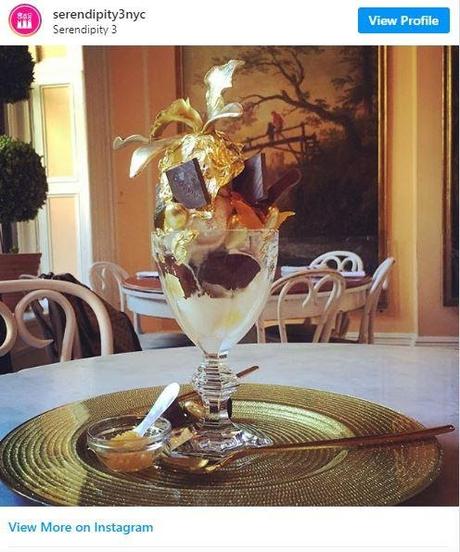
So consider next time you looking at a produce advert, reaching for an exotic fruit at your local market, or centering your plate for that perfect photo, that despite these acts being encapsulations of modern life, you are taking part in a rich and longstanding cultural tradition.
If you would read more about Italian art, culture, history and food, check out these posts
Raffaello (Raphael) Master of the High Arts
Spring,Venice, Vivaldi
The Maria Liberati Show
